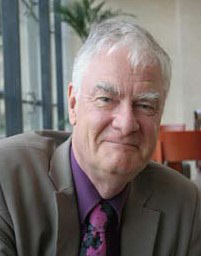The ellipsis, rendered ..., alternatively described as suspension points/dots, or points/periods of ellipsis, or colloquially, dot-dot-dot, is a punctuation mark consisting of a series of three dots. An ellipsis can be used in many ways, including for intentional omission of text or to imply a concept without using words.

Michael Alexander Kirkwood Halliday was a British linguist who developed the internationally influential systemic functional linguistics (SFL) model of language. His grammatical descriptions go by the name of systemic functional grammar. Halliday described language as a semiotic system, "not in the sense of a system of signs, but a systemic resource for meaning". For Halliday, language was a "meaning potential"; by extension, he defined linguistics as the study of "how people exchange meanings by 'languaging'". Halliday described himself as a generalist, meaning that he tried "to look at language from every possible vantage point", and has described his work as "wander[ing] the highways and byways of language". But he said that "to the extent that I favoured any one angle, it was the social: language as the creature and creator of human society".

Systemic functional grammar (SFG) is a form of grammatical description originated by Michael Halliday. It is part of a social semiotic approach to language called systemic functional linguistics. In these two terms, systemic refers to the view of language as "a network of systems, or interrelated sets of options for making meaning"; functional refers to Halliday's view that language is as it is because of what it has evolved to do. Thus, what he refers to as the multidimensional architecture of language "reflects the multidimensional nature of human experience and interpersonal relations."

A figure of speech or rhetorical figure is a word or phrase that intentionally deviates from straightforward language use or literal meaning to produce a rhetorical or intensified effect. In the distinction between literal and figurative language, figures of speech constitute the latter. Figures of speech are traditionally classified into schemes, which vary the ordinary sequence of words, and tropes, where words carry a meaning other than what they ordinarily signify.

In rhetoric, a rhetorical device, persuasive device, or stylistic device is a technique that an author or speaker uses to convey to the listener or reader a meaning with the goal of persuading them towards considering a topic from a perspective, using language designed to encourage or provoke an emotional display of a given perspective or action. They seek to make a position or argument more compelling than it would otherwise be.
In corpus linguistics, a collocation is a series of words or terms that co-occur more often than would be expected by chance. In phraseology, a collocation is a type of compositional phraseme, meaning that it can be understood from the words that make it up. This contrasts with an idiom, where the meaning of the whole cannot be inferred from its parts, and may be completely unrelated.
In linguistics, anaphora is the use of an expression whose interpretation depends upon another expression in context. In a narrower sense, anaphora is the use of an expression that depends specifically upon an antecedent expression and thus is contrasted with cataphora, which is the use of an expression that depends upon a postcedent expression. The anaphoric (referring) term is called an anaphor. For example, in the sentence Sally arrived, but nobody saw her, the pronoun her is an anaphor, referring back to the antecedent Sally. In the sentence Before her arrival, nobody saw Sally, the pronoun her refers forward to the postcedent Sally, so her is now a cataphor. Usually, an anaphoric expression is a pro-form or some other kind of deictic expression. Both anaphora and cataphora are species of endophora, referring to something mentioned elsewhere in a dialog or text.
In sociolinguistics, a register is a variety of language used for a particular purpose or particular communicative situation. For example, when speaking officially or in a public setting, an English speaker may be more likely to follow prescriptive norms for formal usage than in a casual setting, for example, by pronouncing words ending in -ing with a velar nasal instead of an alveolar nasal, choosing words that are considered more formal, such as father vs. dad or child vs. kid, and refraining from using words considered nonstandard, such as ain't and y'all.
In pragmatics, exophora is reference to something extratextual, i.e. not in the immediate text, and contrasts with endophora. Exophora can be deictic, in which special words or grammatical markings are used to make reference to something in the context of the utterance or speaker. For example, pronouns are often exophoric, with words such as "this", "that", "here", "there", as in that chair over there is John's said while indicating the direction of the chair referred to. Given "Did the gardener water those plants?", it is quite possible that "those" refers back to the preceding text, to some earlier mention of those particular plants in the discussion. But it is also possible that it refers to the environment in which the dialogue is taking place—to the "context of situation", as it is called—where the plants in question are present and can be pointed to if necessary. The interpretation would be "those plants there, in front of us". This kind of reference is called exophora, since it takes us outside the text altogether. Exophoric reference is not cohesive, since it does not bind the two elements together into a text.
In linguistics, coreference, sometimes written co-reference, occurs when two or more expressions refer to the same person or thing; they have the same referent. For example, in Bill said Alice would arrive soon, and she did, the words Alice and she refer to the same person.
Text linguistics is a branch of linguistics that deals with texts as communication systems. Its original aims lay in uncovering and describing text grammars. The application of text linguistics has, however, evolved from this approach to a point in which text is viewed in much broader terms that go beyond a mere extension of traditional grammar towards an entire text. Text linguistics takes into account the form of a text, but also its setting, i. e. the way in which it is situated in an interactional, communicative context. Both the author of a text as well as its addressee are taken into consideration in their respective roles in the specific communicative context. In general it is an application of discourse analysis at the much broader level of text, rather than just a sentence or word.
Coherence in linguistics is what makes a text semantically meaningful. It is especially dealt with in text linguistics. Coherence is achieved through syntactic features such as the use of deictic, anaphoric and cataphoric elements or a logical tense structure, and semantic features such as presuppositions and implications connected to general world knowledge.

A bilingual dictionary or translation dictionary is a specialized dictionary used to translate words or phrases from one language to another. Bilingual dictionaries can be unidirectional, meaning that they list the meanings of words of one language in another, or can be bidirectional, allowing translation to and from both languages. Bidirectional bilingual dictionaries usually consist of two sections, each listing words and phrases of one language alphabetically along with their translation. In addition to the translation, a bilingual dictionary usually indicates the part of speech, gender, verb type, declension model and other grammatical clues to help a non-native speaker use the word. Other features sometimes present in bilingual dictionaries are lists of phrases, usage and style guides, verb tables, maps and grammar references. In contrast to the bilingual dictionary, a monolingual dictionary defines words and phrases instead of translating them.
In linguistics, the term lexis designates the complete set of all possible words in a language, or a particular subset of words that are grouped by some specific linguistic criteria. For example, the general term English lexis refers to all words of the English language, while more specific term English religious lexis refers to a particular subset within English lexis, encompassing only words that are semantically related to the religious sphere of life.
The sequence between semantic related ordered words is classified as a lexical chain. A lexical chain is a sequence of related words in writing, spanning narrow or wide context window. A lexical chain is independent of the grammatical structure of the text and in effect it is a list of words that captures a portion of the cohesive structure of the text. A lexical chain can provide a context for the resolution of an ambiguous term and enable disambiguation of concepts that the term represents.

In systemic functional grammar (SFG), a nominal group is a group of words that represents or describes an entity, for example The nice old English police inspector who was sitting at the table with Mr Morse. Grammatically, the wording "The nice old English police inspector who was sitting at the table with Mr Morse" can be understood as a nominal group, which functions as the subject of the information exchange and as the person being identified as "Mr Morse".

In rhetoric, a scheme is a type of figure of speech that relies on the structure of the sentence, unlike the trope, which plays with the meanings of words.

Michael Hoey was a British linguist and Baines Professor of English Language. He lectured in applied linguistics in over 40 countries.

Ruqaiya Hasan was a professor of linguistics who held visiting positions and taught at various universities in England. Her last appointment was at Macquarie University in Sydney, from which she retired as emeritus professor in 1994. Throughout her career she researched and published widely in the areas of verbal art, culture, context and text, text and texture, lexicogrammar and semantic variation. The latter involved the devising of extensive semantic system networks for the analysis of meaning in naturally occurring dialogues.
The term metafunction originates in systemic functional linguistics and is considered to be a property of all languages. Systemic functional linguistics is functional and semantic rather than formal and syntactic in its orientation. As a functional linguistic theory, it claims that both the emergence of grammar and the particular forms that grammars take should be explained "in terms of the functions that language evolved to serve". While languages vary in how and what they do, and what humans do with them in the contexts of human cultural practice, all languages are considered to be shaped and organised in relation to three functions, or metafunctions. Michael Halliday, the founder of systemic functional linguistics, calls these three functions the ideational, interpersonal, and textual. The ideational function is further divided into the experiential and logical.